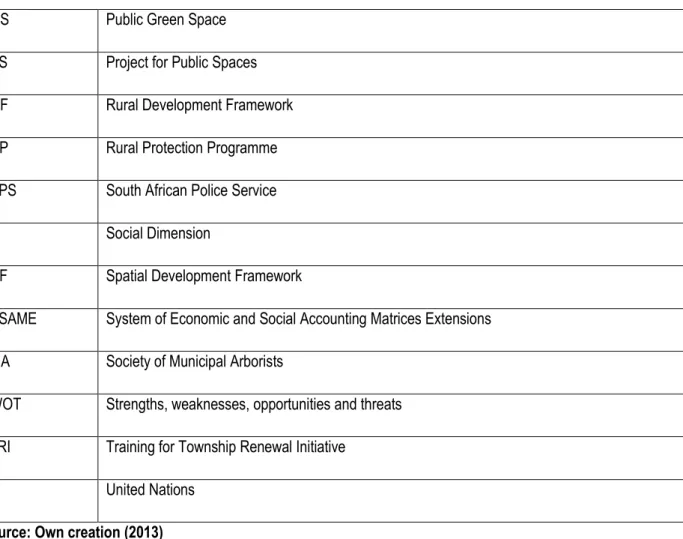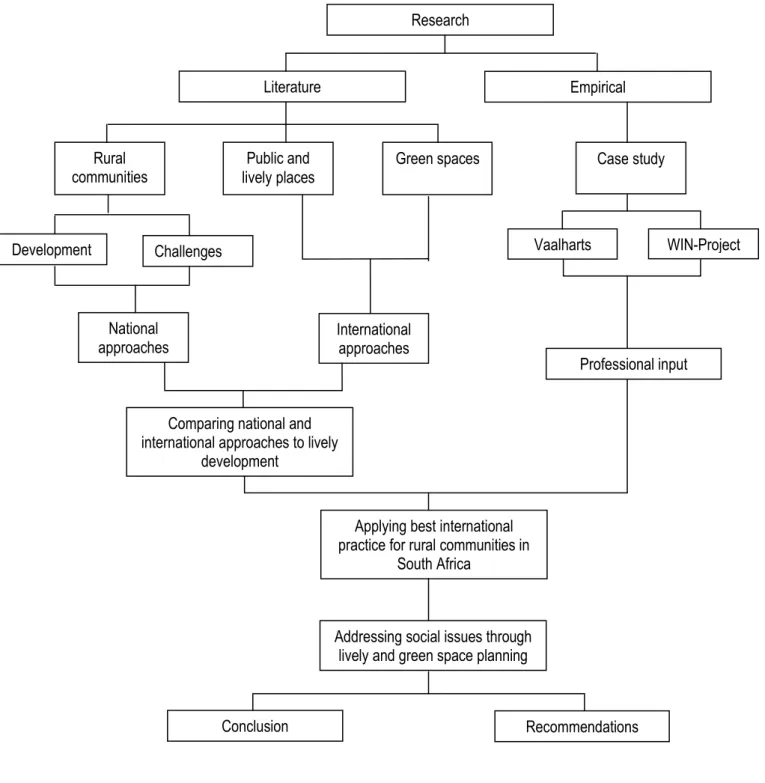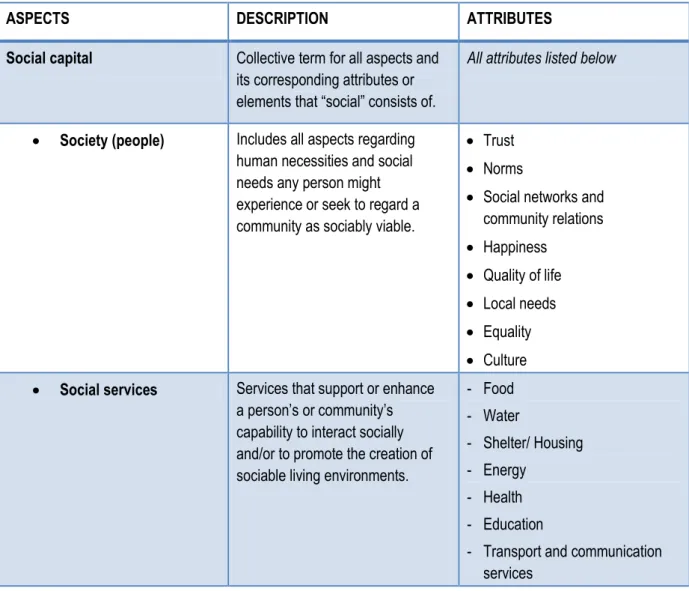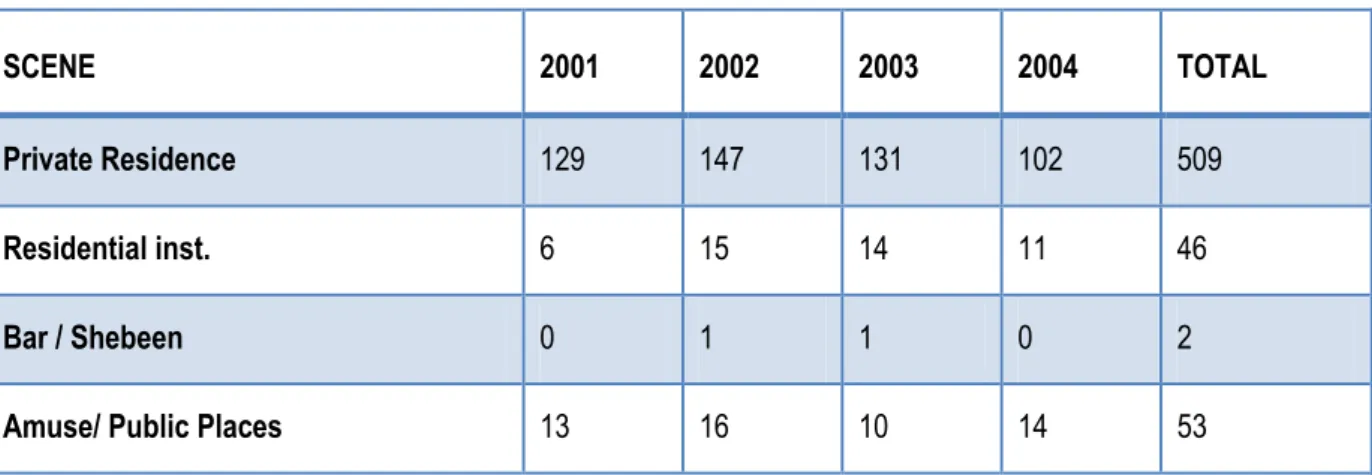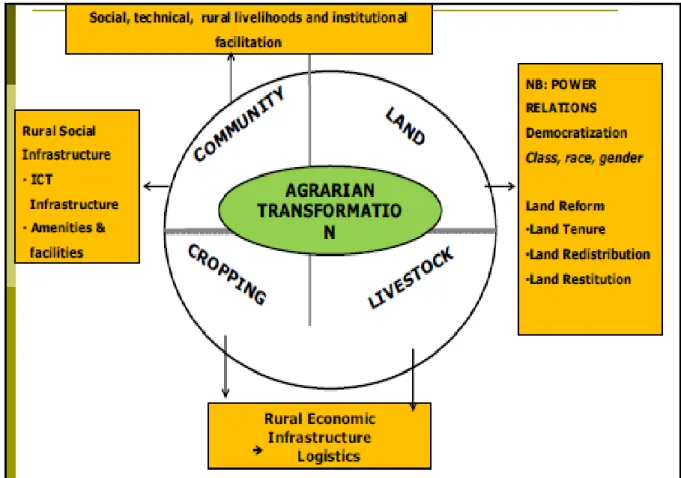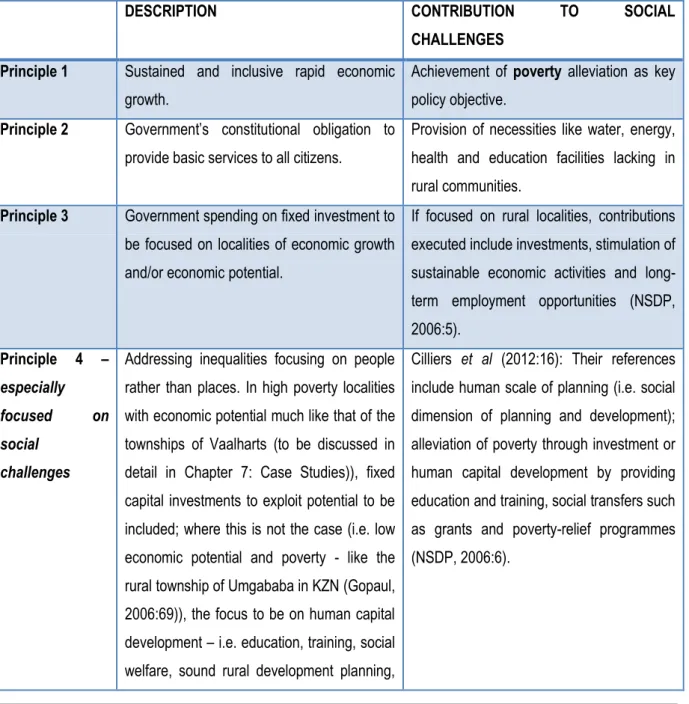The research question therefore focuses on whether the planning of lively places and green areas in rural areas can address some of these social issues, and contribute to strengthening local communities and creating lively public places. This study can serve as a link between literature and practical rural issues, as well as contribute to green spaces and lively place development, incorporate international approaches and pilot studies and illustrate best practices regarding lively place and green space development, linking it to the local rural reality.
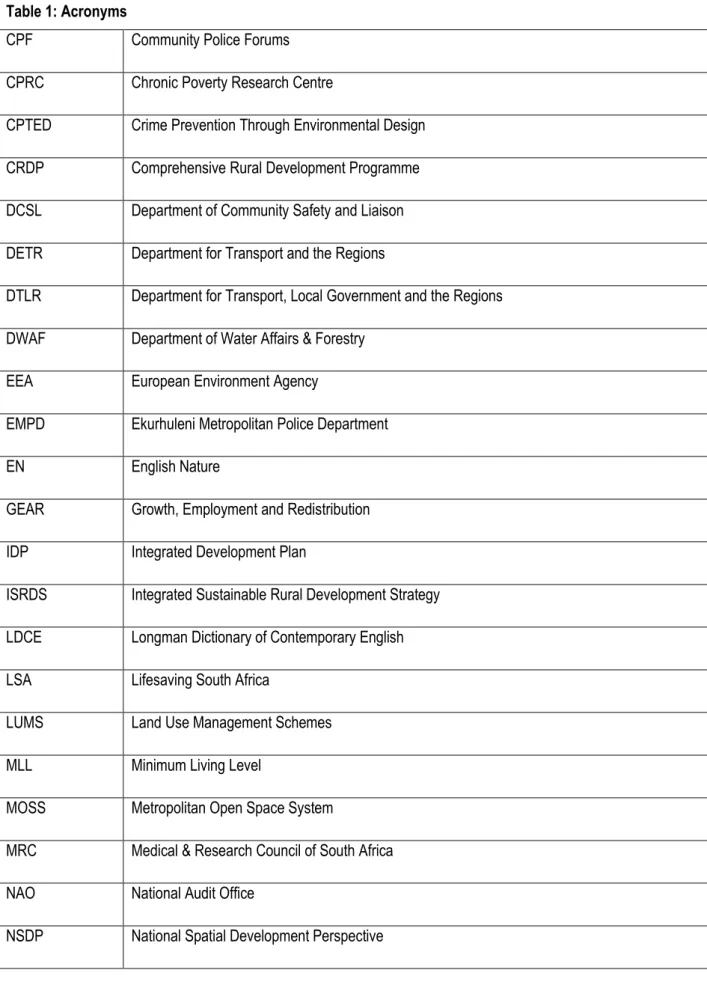
INTRODUCTION
- Points of departure
- Problem statement
- Primary research questions
- Aims and objectives of this study
- Method
- Delineation of the Study Area
- Limitations of the research
- Structure of the dissertation
- Definitions
Is it possible to address social issues within rural communities through the planning of living places and green spaces. This research primarily aims to address social issues (such as safety and security) specific to rural communities in South Africa in a sustainable way by planning (and improving) living places and green spaces within rural communities.
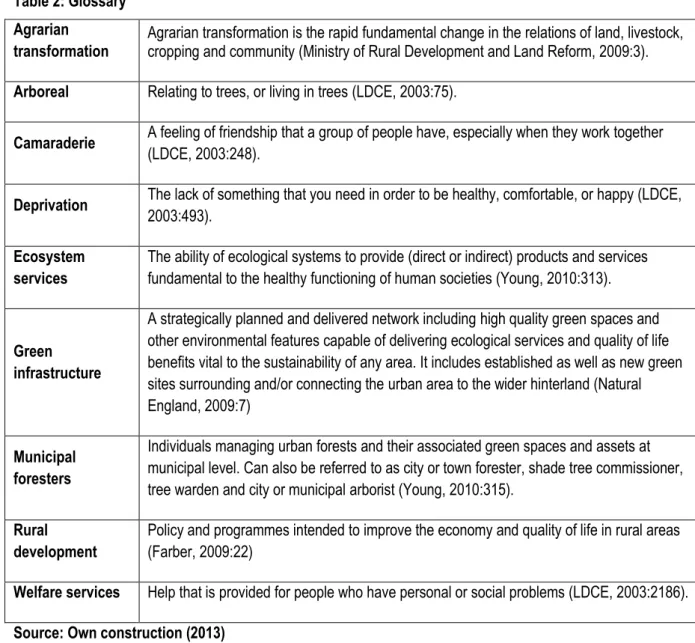
RURAL COMMUNITIES AND DEVELOPMENT
The local rural reality in South Africa
- Defining ‗rural‘
- Primary (social) rural challenges
In ISRDS (Department of Rural Development and Land Reforms), this 'social' component has come to be known as 'social capital'. Thus, the social aspect is equality (according to Veenhoven and Ehrhardt (1995:20) social equality includes social security, gender equality and income equality), but related factors or situations (dispersion and social inequality) can be seen and included in the concept of "social challenges".
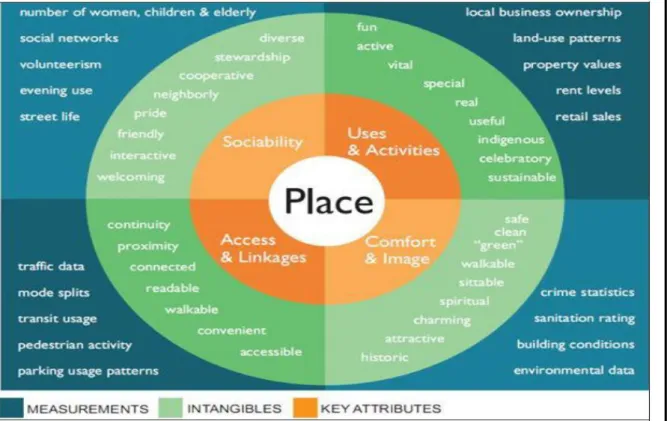
Addressing the social challenges in rural areas of South Africa by means of planning
- Understanding ―social planning‖
- Current rural planning legislation and policies in SA
- Frameworks guiding social dimension planning in South Africa
- South African framework and legislation approach to social issues: safety and security
To increase employment and economic growth in rural areas (with unemployment as one of the main social challenges within rural communities – refer to Table 4);. Broadly speaking, it contains (in most cases) all the social challenges identified and discussed in Table 4 in Section 2.1.2.1 of this thesis.
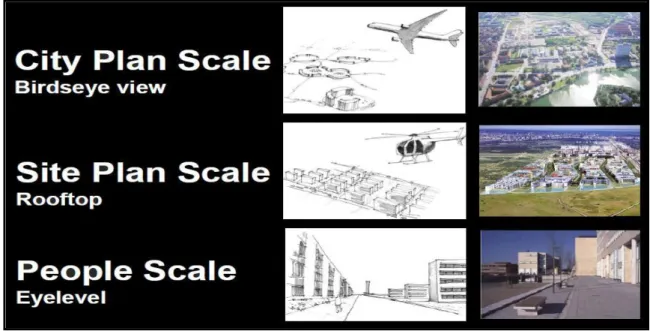
PLANNING OF PUBLIC AND LIVELY PLACES
Introduction
In this section, the planning of a lively place will be discussed by first addressing and defining the two aspects (public spaces and lively places) separately and then discussing the whole of the concept with specific reference to South African and international concepts and approaches for the planning of vibrant local communities to identify whether the planning of such places in rural areas can solve social problems and help to strengthen sustainable communities.
Defining public and lively places
- Creating a public place
- Planning for lively places
- Social benefits of public and lively place planning
Another living international place planning approach or project (so not a framework but an initiative as mentioned above) is the concept of "regeneration" (as implemented in Paris, France within the Verger district). Another approach to vibrant site planning within South Africa is that of Community Crime Prevention Initiatives. Another South African policy implemented to be considered a viable country planning approach is the ISRDS (Integrated Sustainable Rural Development Strategy).
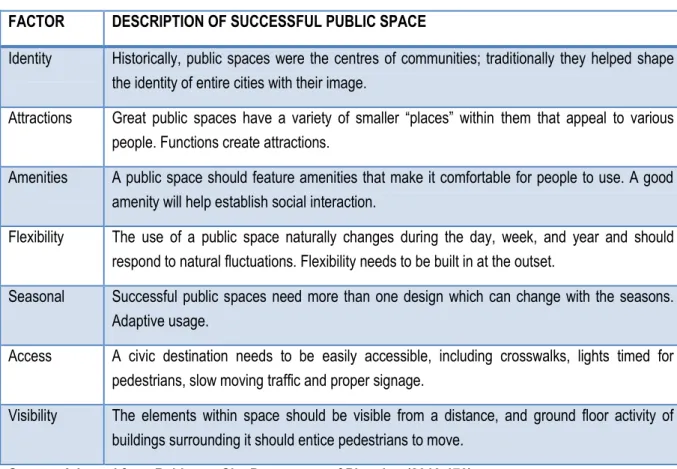
Place-making approaches
- Elements of place-making
- Theories regarding place-making
- Impact of place-making theories on rural safety and security
Placemaking is (as mentioned) primarily focused on public spaces and creating places to socialize and interact. This section focuses on theories and approaches of place-making with specific reference to rural communities and the impact on the (social) security challenge present in rural communities. By applying place-making processes and/or lessons, small actions can contribute to a large extent in addressing rural safety and security as a social challenge.
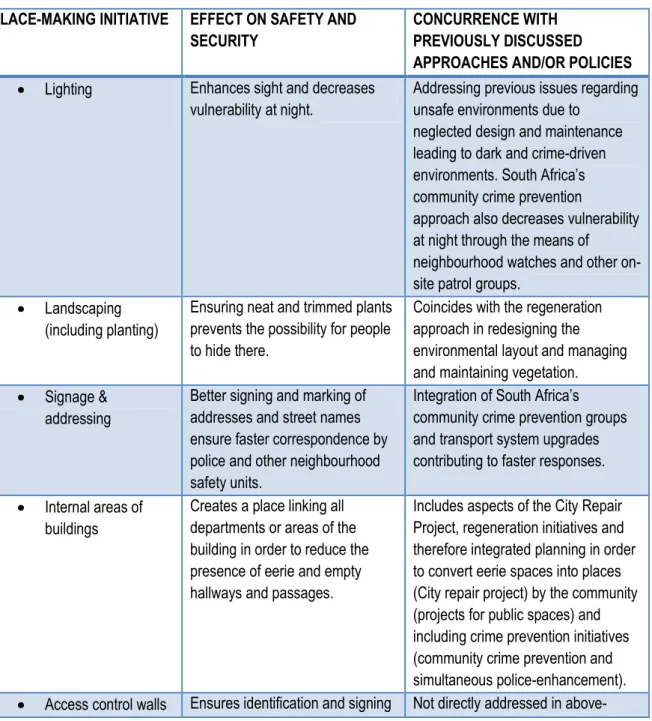
Planning of lively places to address social challenges
Therefore, the simultaneous involvement and presence of on-site managers in the planning and maintenance of vibrant places is necessary to successfully address social challenges. This underpins the success of devolution to local authorities and the creation of alliances to tackle social challenges within vibrant place planning. As safety and security and any other social challenges are only partially met by putting more police officers on the streets (Philips' implementation or execution of planning frameworks (such as the Rural Safety Strategy and others) successfully implements the elements of vibrant place planning aimed at successfully improving social challenges in rural areas (SAPS.
GREEN SPACE PLANNING
Introduction
Defining „green spaces‟
Beach fronts are not considered green spaces as they do not meet the requirements of the definition of being a vegetated space (Shackleton & Blair as previously defined by Shackleton and Blair and Barbosa et al. This supports the multidimensional principal component analysis of Baycan- Levent (2007:1) as an approach to the effective provision and maintenance of green spaces. It also includes Shackleton and Blair's analogy between the quality and value of green spaces, as well as the contribution and importance of human-driven green spaces, with public participation that will be discussed in the following sections.
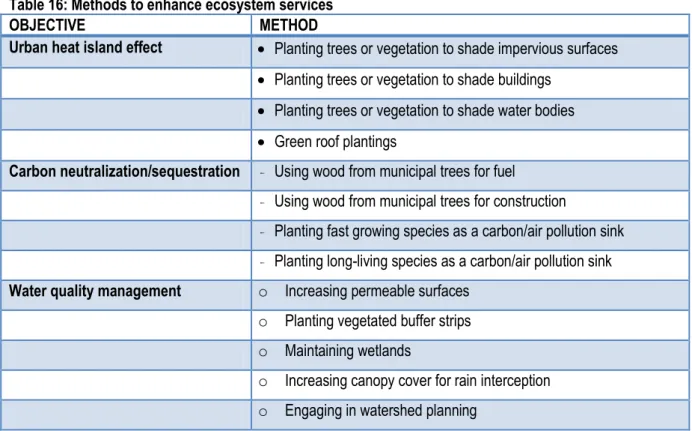
Challenges and understanding of the context of green spaces
These above-mentioned values of green spaces can be considered subjective, identifying different views on the value and functions of urban green space according to the New Labor Government. Baycan-Levent (2007:9) also emphasizes the importance of the quantity of green space as “a key issue among the success factors in the planning and management of urban green spaces”. The emphasis here is on the benefits of green spaces with regard to biodiversity (Barbosa et al.
Green spaces and social challenges
- International context
- International case studies
- South African context
- Comparing factors of successful green space case studies
To provide a coherent structure for planning, local authorities are recommended to develop a green space planning. One of the very successful implementations of green space planning is the case study of Käferberg in the city of Zurich, Switzerland. Providing green spaces (sports fields listed as a type of green space); improving the planning aspects of green space for tourism benefits and purposes; promoting green technologies in terms of minimizing energy and water consumption.

Role of green spaces in enhancing social benefits
Another important aspect or success factor worth mentioning is the need for green space planning to be safe - safety in terms of violence and crime inhibition, as well as safety in terms of child safety measures and provision for the needs of the elderly and disabled (Barbosa) et al.. Benefits of green space planning for human well-being include livelihood provision, health improvements, stress reduction, rejuvenation and recreational activities, as well as providing a sense of peace and tranquility (Ward et al., 2009:49). , the value of green space planning (especially in relation to its contribution to vibrant place planning) and social challenges can be summarized as seen in Table 21 (Beneficial social values due to green space planning).
The role of green space planning in creating lively places
The following table illustrates different levels and the corresponding contribution of green space planning to solving social issues (cross-reference to Table 4: Summary of social challenges in rural areas). The important influence of green space planning on lively site planning can be concluded in the statement made by the Ministry of Transport, Municipalities and Regions (2002:71). Therefore, the main value of green space planning is its diverse approach, based on what local people want and need, i.e.
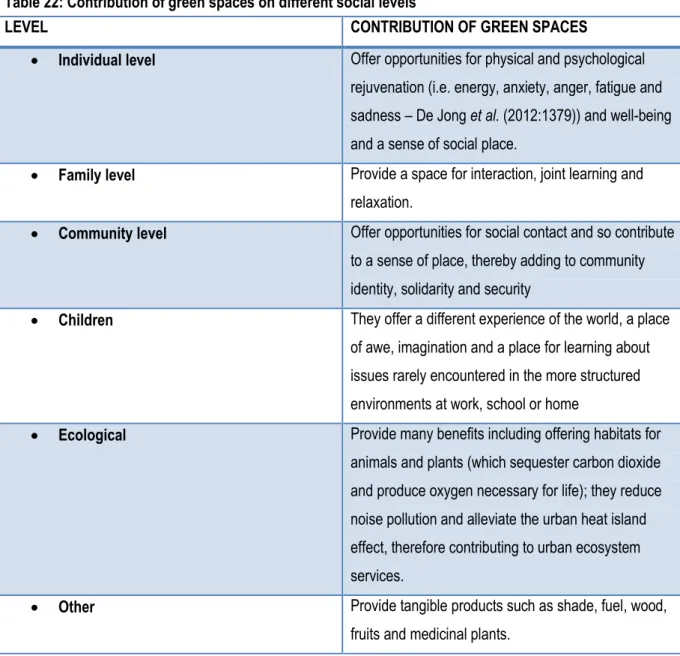
Rural communities and the social benefit of green space planning
- Impact of green space provision on safety and security of rural areas
Psychological access is also a valuable aspect regarding green space planning and is related to PGS being attractive (or not), being safe for potential users and fulfilling the purpose for visiting a PGS (Shackleton & Blair, 2013: 105). The reduction of densely vegetated green spaces reduces the possibility and opportunity for criminals to hide (Walton et al and therefore provides for better safety within the green space. It is essential for communities to include green space planning as part of any revitalization initiative in order to successfully plan vibrant places (House of Commons (2003:9); Swanwick et al.
Collaborate: Lively place and green space planning relevance in rural communities
- Background: Rural challenges and lively place and green space planning
- Evaluating the concept of lively place planning in terms of rural development
- Success aspects in terms of rural development
- Effect on safety and security of a rural area
As discussed in Chapters 3 and 4, vibrant place planning and green space planning are forms or approaches considered or included as social planning approaches. This section demonstrates unquestionable coherence and visible independence regarding rural (societal) challenges and social planning, such as vibrant place planning and green space planning. Rural communities still remain unique and challenging, so not all approaches to planning vibrant places and green spaces will work (Chapters 3 and 4).
INTERNATIONAL CASE STUDIES OF GREEN SPACE PLANNING AND APPROACHES
Introduction
International lively place planning: Approach analysis
- Point of departure: planning lively places
- International case studies: Lively place planning and place-making
These issues will provide the basis against which current international case studies on vibrant place planning will be evaluated. The Planning of Lively Places has 11 identified measurements. Therefore, the applicable approach to the planning of vibrant places will be evaluated in terms of a score out of 11 – that is, the following table identifies and briefly summarizes the main concerns of the approaches to the planning of vibrant places discussed in Chapter 3 summarizes.
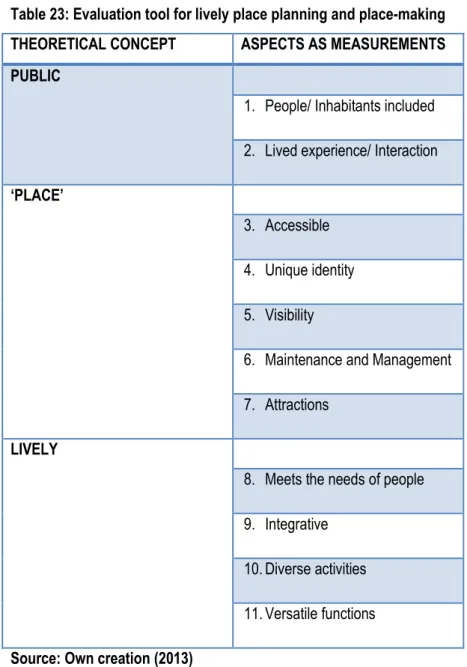
International green space planning: Case study analysis
- Point of departure: planning of green spaces
- International case studies: Green space planning
The following table shows and briefly summarizes all the approaches to green space planning discussed in Chapter 4. The aim of this table is therefore to determine whether these case studies successfully address and plan green spaces based on the theoretical objectives of green space planning (Chapter 4). ), as summarized above in Section 5.3.1. In terms of the above-mentioned summary or definition of green space planning, this approach is successful from the point of view of recommending consideration of access to green spaces.
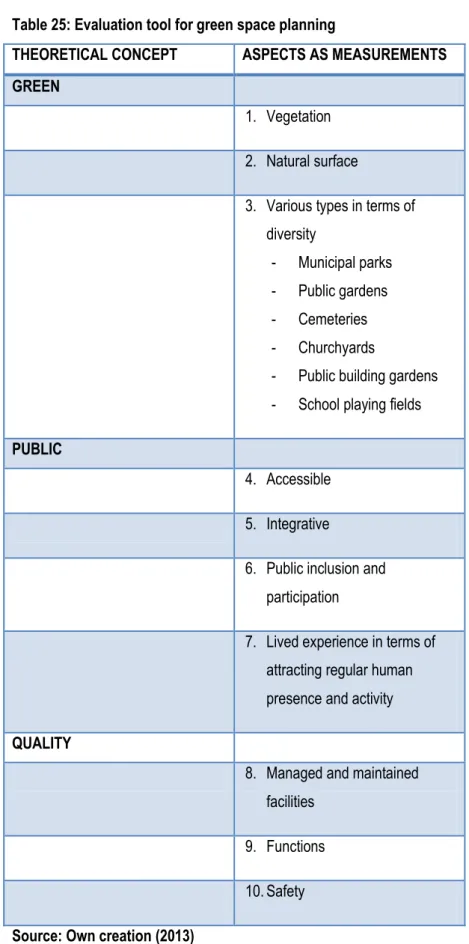
Discussion and implications of findings
The approach cannot be seen as a best practice when only one aspect of green areas is planned. The Netherlands 5 out of 10 This approach receives similar criticism as above, focusing on improving access and not green space planning in general. 4 out of 10 The failure to include or provide for public activities and/or functions prevents the mere protection of green spaces from being considered successful.
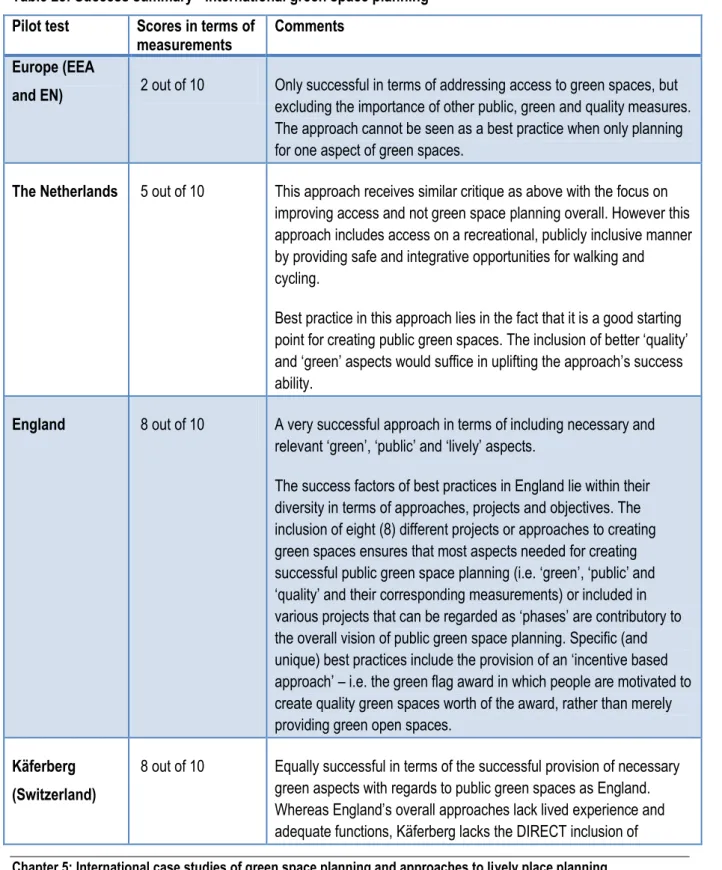
Chapter conclusion
LOCAL CASE STUDIES OF GREEN SPACE PLANNING AND APPROACHES TO LIVELY
Introduction
Local lively place planning: Approach analysis
- Point of departure: Planning lively public places locally
- Local case studies: Lively place planning and place-making
The same steps used and identified in Chapter 5, subsection 5.2.1 for the evaluation of international vibrant place planning approaches and green space case studies also apply to the evaluations to be carried out in this chapter for local vibrant place planning approaches and green space planning cases. surveys. The following table indicates and briefly summarizes the main focus of the local approaches to lively place planning and placemaking as discussed in Chapter 3. This table aims to analyze whether these local case studies and approaches successfully address and plan lively places based on the theory of lively place planning (chapter 3) according to the three main theoretical concepts and the corresponding measurements as identified, namely public, place and lively.
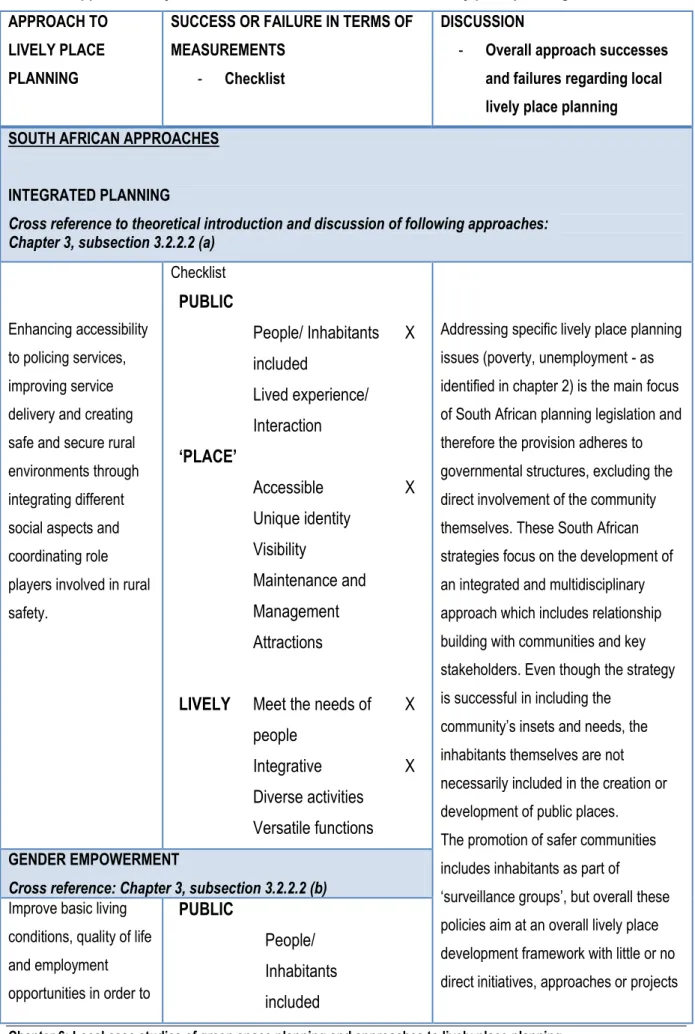
Local green space planning: Case study analysis
- Point of departure: Planning of green spaces locally
- Local case studies: Green space planning
Successful in providing guidance on improving the accessibility and quantity of green spaces within a specific area, as well as improving an area by providing an aspect of green space planning – trees – planted by (and therefore by including) the community itself. However, as previously mentioned, South Africa (in general) lacks green space planning (as described and defined by theory) and therefore simply maintaining and managing current “open spaces” is not sufficient as a “ public green space planning approach". Although the focus is mainly on climate change and environmental aspects, the inclusion of various projects enhances this case study of green space.
Discussion and implications
Department of Water Affairs and Forests). in most cases simple open spaces) is not enough to be considered successful green space planning. 7 of 10 It is evident that the inclusion of different and diverse projects is the best practice to implement in any community or area. 6 out of 10 botanical gardens can be considered as a very good example of a secured "green" space with the necessary maintenance, management, opportunities, etc.
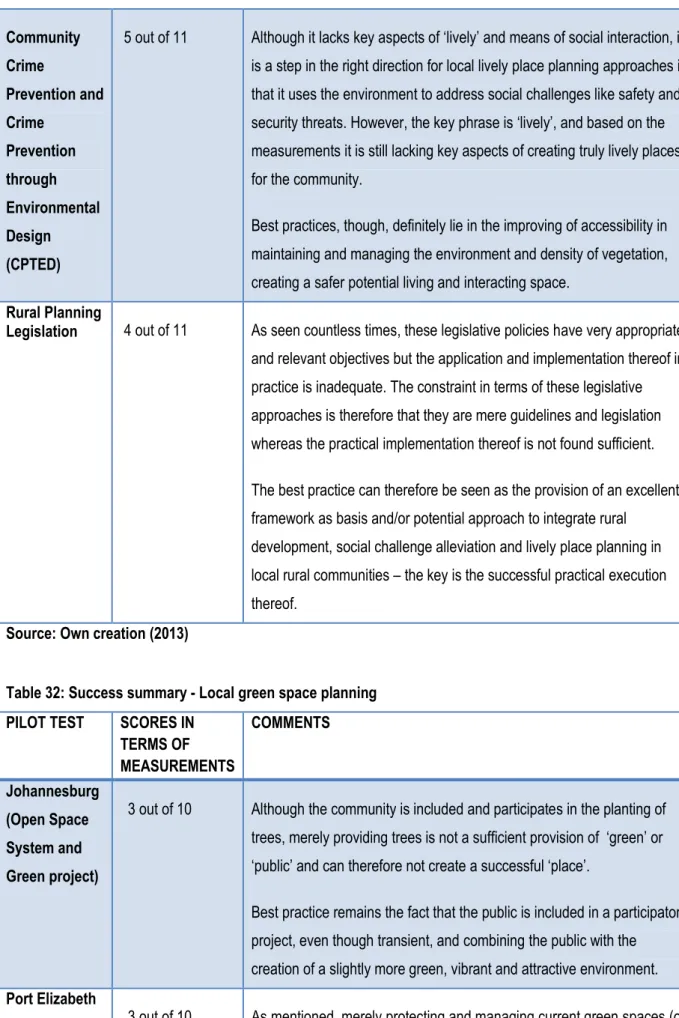
Application to local pilot tests
- Nigel and Zonkizizwe – Ekurhuleni Metropolitan
- Umgababa – KwaZulu-Natal
- Comparing local pilot tests: Best practices in terms of lively place and green space planning
The aspect of planning lively places and green spaces of public participation (as successfully applied and identified in the tables). The second pilot test to determine the empirical potential relevance and success in terms of planning vibrant places and green spaces, as well as aspects of success in addressing rural challenges, is that of the community of Umbababa. When applied to this situation of socio-economic progress, the planning of vibrant places and green spaces offers an approach where.
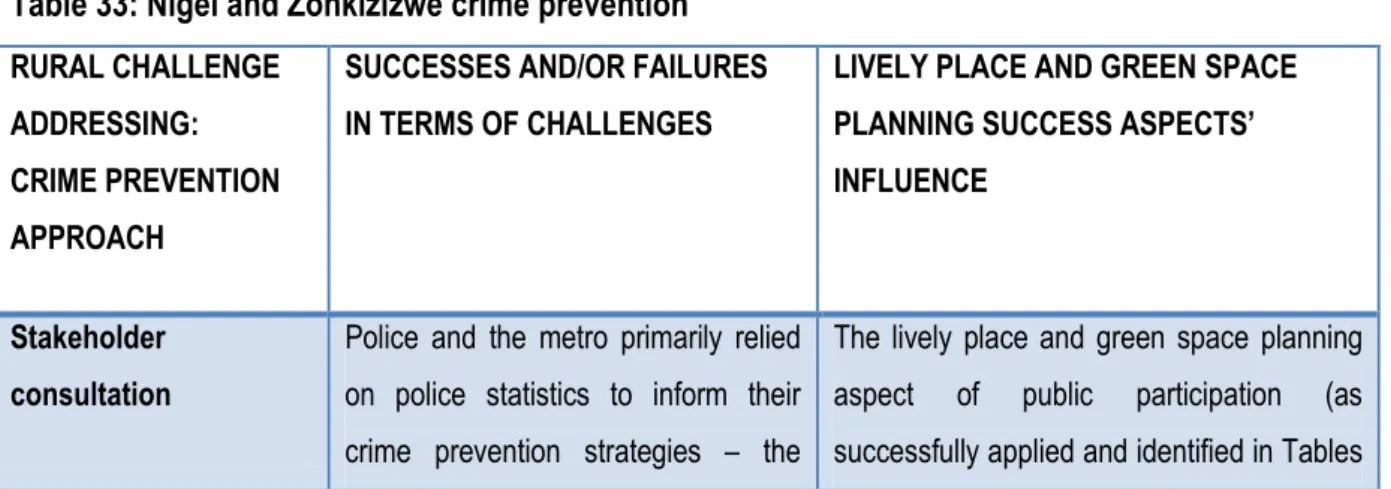
Chapter conclusion
APPLICATION OF FINDINGS-VAALHARTS CASE STUDY
Introduction to the Vaalharts area
Current rural situation in Vaalharts
- Previous research conducted in the Vaalharts region
- Needs identification and prioritization in the Vaalharts region
- Current initiatives attempting to address challenges
Needs-analysis
- Statistical analysis of needs
- Gap analysis of current needs and challenges to be addressed
- Strengths, weaknesses, opportunities and threats
Interpretation of analysis in terms of the social dimension of planning
- Safety and security as social challenges in the Vaalharts area
- Evaluation of current initiatives to address social challenges in the Vaalharts area
- Potential benefit of integrating social planning initiatives in the Vaalharts area
Evaluating the WIN-project as initiative to address Vaalharts-challenges
- Background and information regarding WIN-project
- Evaluation of WIN-project initiatives in terms of social dimension planning
- Success in terms of addressing safety and security challenges in the Vaalharts
Results and findings
CONCLUSIONS
Introduction
Linking theory and practice
- Rural challenges and corresponding lively place and green space planning influence
- International and local best practice approaches and case studies
- Application of best practices in rural communities
- Implementation of best practices in addressing pilot test challenges
Synopsis
RECOMMENDATIONS
Introduction
The integration of lively place and green space planning
Practical implementation strategies and initiatives
- Universal recommended application of ‗lively and green public place planning‘ for rural communities
- Recommended implementation of social planning elements in local pilot tests and the Vaalharts case study
Conclusion
